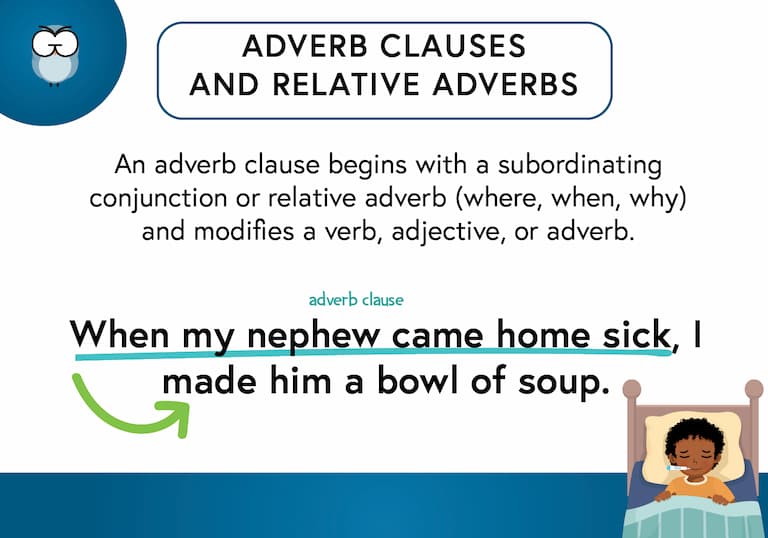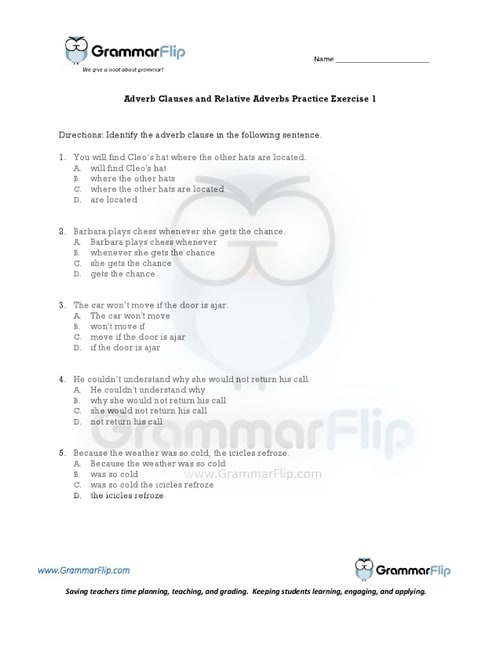What is an Adverb Clause?
An adverb clause is a type of relative clause that modifies a verb, adjective, or adverb, and it begins with a subordinating conjunction or relative adverb (where, when, or why).
Some examples of adverb clauses would be the following:
You can find flour where the other baking ingredients are located.
When my nephew came home sick from school, I made him a bowl of hot soup.
With all her previous restaurant experience, Kate could not understand why she did not get the waitressing job.
Long-Form Videos: Adverb Clauses
Long-form instructional video lessons allow students to engage with grammar concepts in more depth and detail.
This format provides students with a stronger foundation and a more comprehensive understanding of adverb clauses.
Short-Form Videos: Adverb Clauses
Short-form videos are an excellent way to review grammar concepts. Our two-minute instructional videos help students review the concept of adverb clauses to further solidify their understanding.
Definition Cards: Adverb Clauses

Definition cards reinforce grammar concepts by providing clear and concise explanations that students can easily reference for quick review and better retention. GrammarFlip’s definintion cards help students review the concept of adverb clauses to further solidify their understanding.
Why You Should Use Adverb Clauses in Your Writing
Keep in mind that adverb clauses are simply dependent clauses that begin with a subordinating conjunction or a relative adverb (when, where, why), and as a whole, they function like an adverb which means they will modify a verb, adjective, or an adverb in the main clause of the sentence.
The benefits of using adverb clauses in your writing is primarily to provide more description or detail about the verb, adjective, or adverb in the main clause of the sentence.
Notice the difference between the following pairs of sentences:
We will start practice.
We will start practice when the coach arrives.
He placed the bowl.
He placed the bowl where the dog could reach it.
Without the adverb clause, there would be quite a bit of detail and context left out of the sentence, so be sure to use adverb clauses in your writing to provide more detail and description.
When you’re ready, be sure to explore noun clauses, adjective clauses, and elliptical clauses, too!
Download a Free Worksheet on Adverb Clauses!
Click the image below to download your free worksheet on adverb clauses!

Need a grammar program that provides the instruction and grading for you?
Explore More GrammarFlip Lessons!
Parts of Speech lessons provide the building blocks of grammar. GrammarFlip covers these topics in detail to ensure a solid foundation is built. First time learners and students seeking to review the parts of speech can both benefit from the instructional videos and slide show reviews.
Parts of the Sentence lessons are critical for understanding how the parts of speech function in language construction. From the basic to the advanced, these lessons will cover a wide range of grammar topics that can be used in any grade level or classroom.
Mechanics and Usage lessons equip students with the necessary skills to communicate clearly to all audiences. With a focus on the application of these concepts in student writing, these lessons tie together both simple constructions of grammar as well as the more complex such that any age or skill level of student will benefit.


